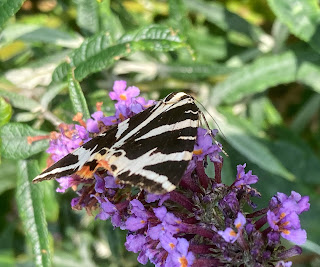I'm two-thirds through the year on my Historic Isle of Purbeck Year List challenge for 2024. The target is to comfortably pass the two hundred species barrier, following BOU taxonomy with no reintroduction species or feral pigeons. I was on 175 at the end of Jul 24, which was relatively disappointing compared to my previous Poole Harbour Year Lists attempts. However, I had been abroad for a month from mid-Jan to mid-Feb and consequentially I missed a good chunk of the first Winter and four expected Winter species: Merlin, Woodcock, Jack Snipe & Brambling. However, Jack Snipe can be tricky to locate at the best of times and Brambling is most easily seen as a Vis Mig species in late Oct - early Nov.
The size of the two areas are broadly similar. Poole Harbour adds in the good & well-watched Lytchett Bay & Swineham patches: which allow a few easy Year Ticks that are very hard to unlikely to see in the Isle of Purbeck such as Bittern, Pochard, Garganey, bonus Waders, Water Pipit etc. But the latter patch includes the Jurassic coastline with easy bonuses such as Red-legged and Grey Partridges, Puffins, Corn Buntings, much better migrant Passerines & seawatching. But a lot fewer Birders watch this coastline and lack of coverage is a downside.
My best ever Poole Harbour Year List is 206 in 2011, with the record of 209 being achieved by Nick Hopper in 2008. In comparison in 2022, I reached 195 by 24 Oct in the Isle of Purbeck and would have finished the year on about 205. But instead, I headed out for two back to back tours to very remote parts of Indonesia with Bird Tour Asia for seven weeks, followed by an eight day bout of Salmonella picked up in Bali or on the plane home. This meant I didn't see any additional species. The Isle of Purbeck Year List record is 202 achieved by James Leaver in 2023.
Wood Sandpiper: This was a species I reckon I only had a slim chance of seeing in the Isle of Purbeck. So, I quickly headed over to Brownsea to see it. I didn't have my camera with me, but I just managed to squeeze it onto the DWT Brownsea TV screen whilst showing it to visitors (3 Aug 24)
Fortunately, Aug 24 has provided a good start to the Autumn, with my first Yellow Wagtails and the bonus Wood Sandpiper on Brownsea at the start of the month. It was the best part of three weeks before I saw another new species, despite getting out every Birding locally nearly every day. The weather cracked up on 22 Aug when Storm Ernesto battered the UK and produced some nice seawatching at Durlston. The highlight was a couple of bonus Sooty Shearwaters, with another on the following morning. That afternoon I finally bumped into a Ring-necked Parakeet. Up to a couple of years ago, this was an easy species to see around Studland and I often bumped into them elsewhere locally. However, I'm only aware of a handful of sightings this year, thanks to a decision by the Studland Golf Course to employ a pest controller to shoot them over the last couple of years.
Ring-necked Parakeet: A few years ago, I started seeing them around my Swanage house. However, thanks to some Parakeet-hating golfers, the small Purbeck population that has probably never reached twenty individuals might well disappear completely (29 Aug 18)
Things picked up when I went to Brownsea on 24 Aug after a Little Stint was found there by local Birder & Brownsea volunteer Graham Armstrong. I then found an eclipse Male Garganey & Graham upped my Year List again with a Curlew Sandpiper. I didn't dare to dream of a three Tick day at this stage of the year.
I thought a Grasshopper Warbler on 29 Aug would be the last Year Tick of the month. However, after a wonderful day spotting on the Birds of Poole Harbour Bird Boat, I was heading home, when local Purbeck Birder James Leaver rang about a Wryneck he had just found on his evening walk patch at Knowle Hill. The car was rapidly spun around in Corfe Castle and a few minutes later, I met up with James. It was a nerve-racking ten minute wait as the sun slowly lowered, but then James saw it pop up again. Another bonus Year Tick that I wasn't banking on, left me on 184 at the end of the month.
Wryneck: We didn't try to get close to get better photos as we didn't want to disturb it, in case other local Birders wanted to look for it the following morning. In the end, nobody did look for it & it could still be around
In addition to the four Winter species, still have a few fairly easy species to see: Storm-petrel, Bonxie, Short-eared Owl, Pied Flycatcher, Yellow-browed Warbler & Ring Ouzel. Then I will be reliant on some scarce & rare Autumn & Winter species to push me over the two hundred barrier. At this point, it seems possible and the challenge will help me get out Birding daily over the next few months.



















































